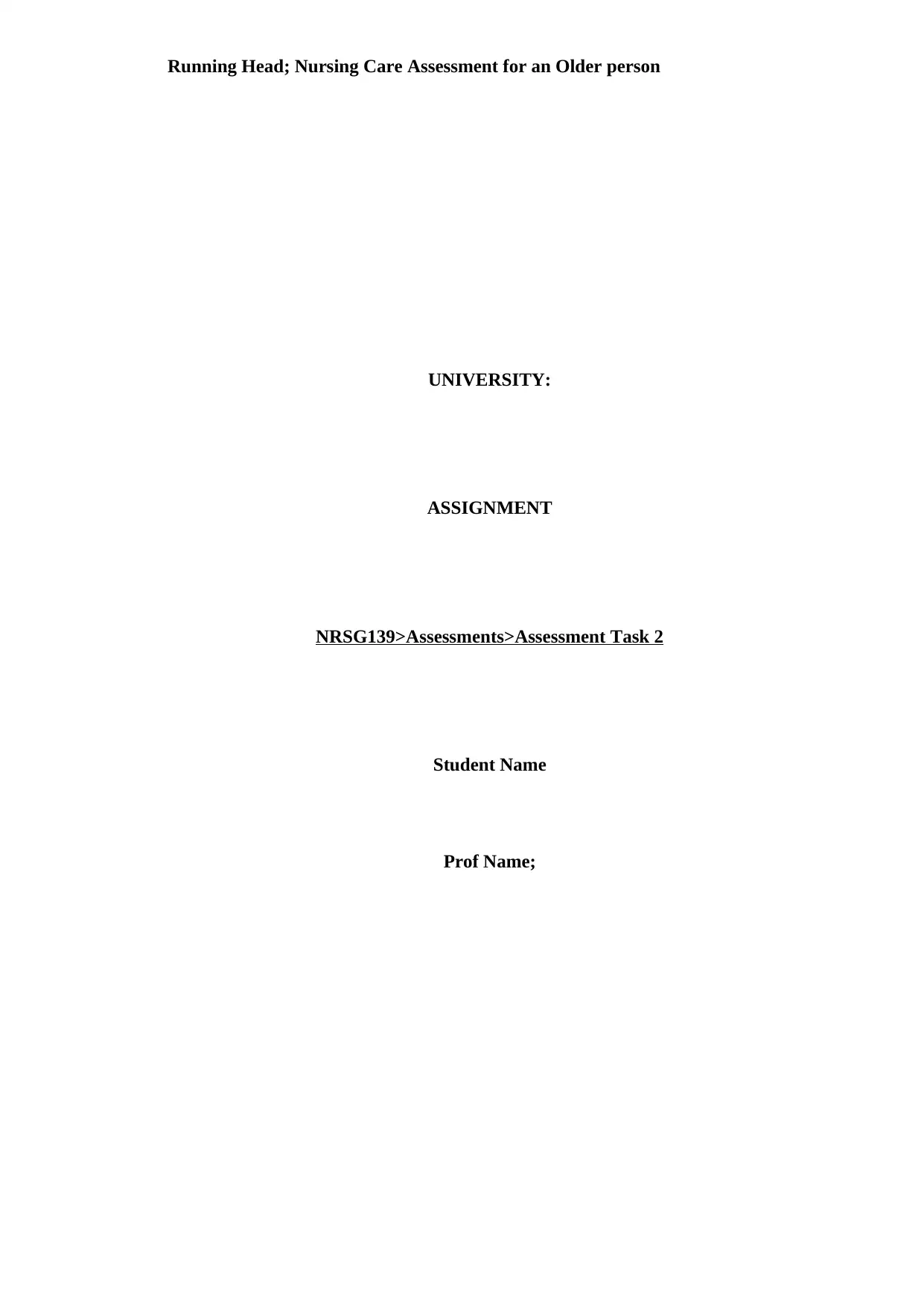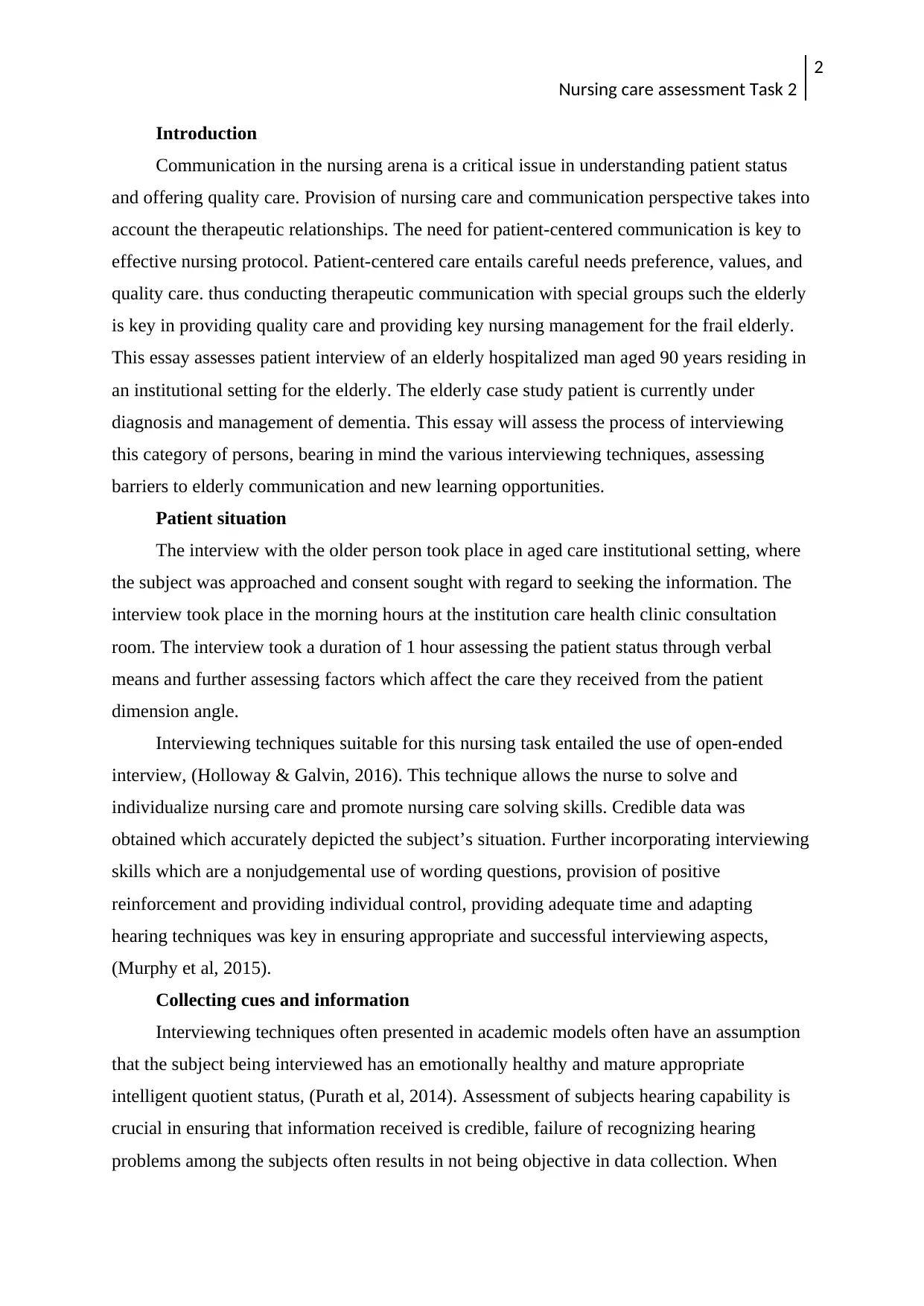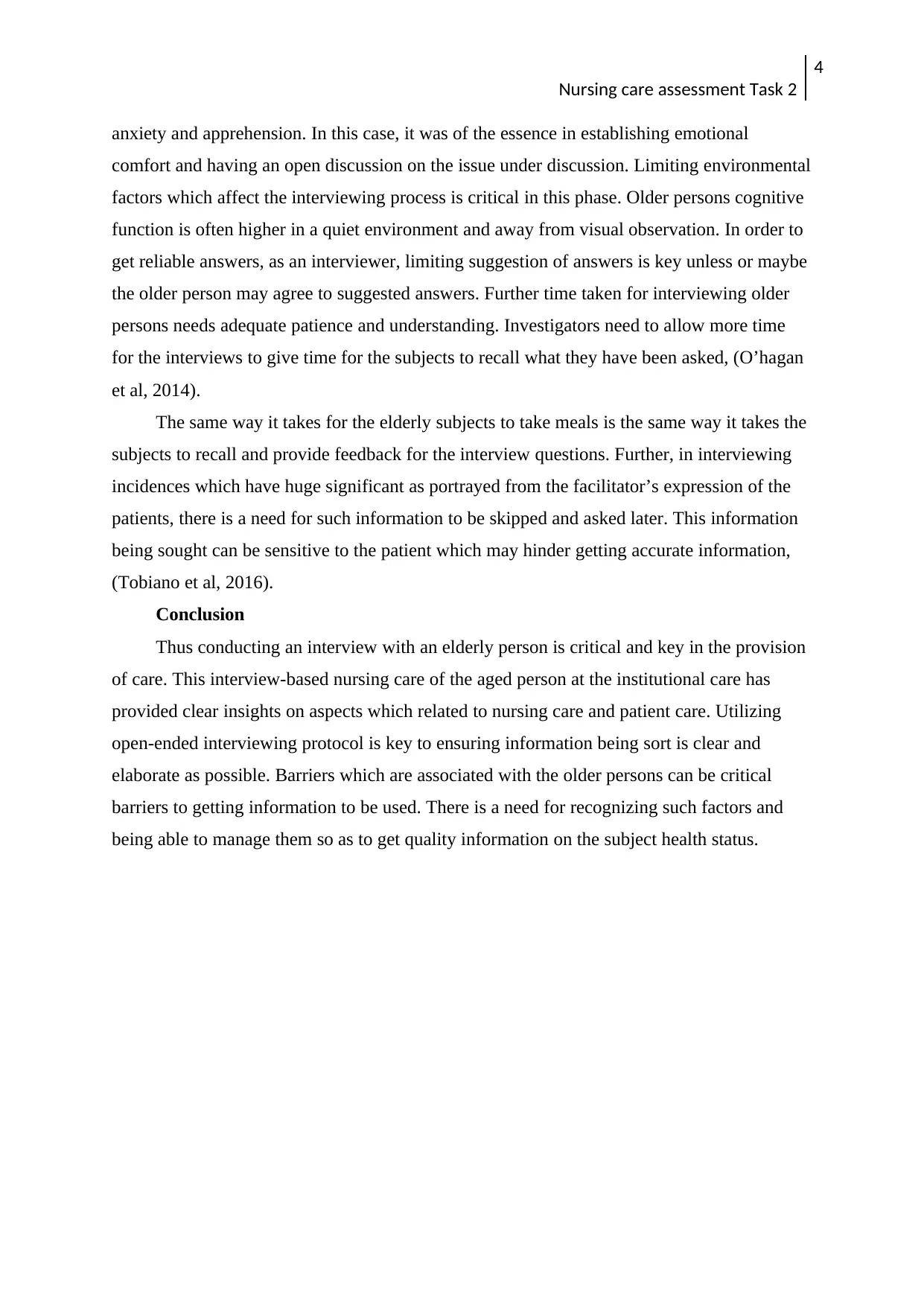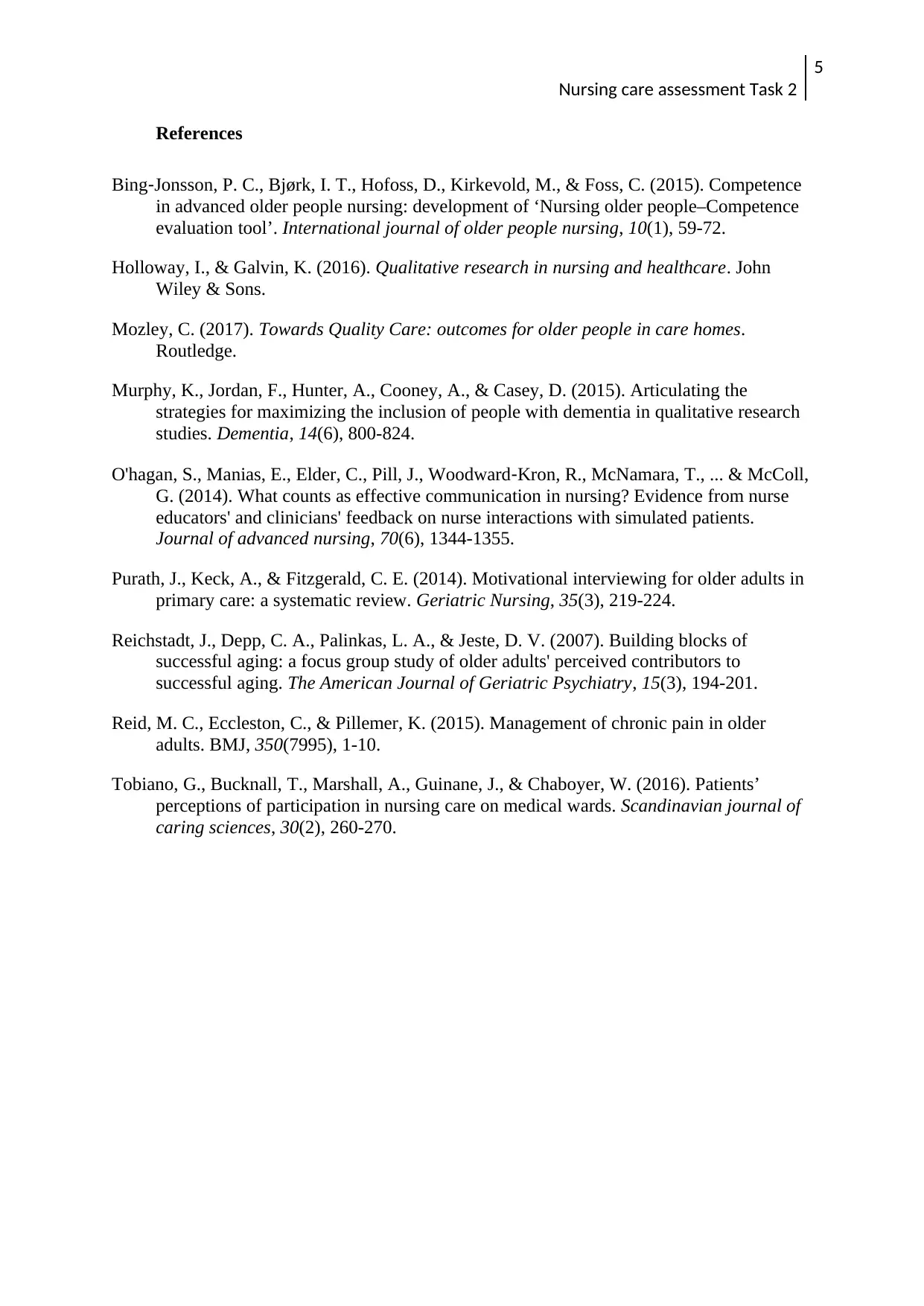NRSG139: Nursing Care Assessment & Interviewing an Elderly Patient
VerifiedAdded on 2023/06/12
|5
|1635
|200
Report
AI Summary
This report provides a nursing care assessment based on an interview with a 90-year-old patient in an aged care facility, focusing on the challenges and techniques involved in communicating with elderly individuals, particularly those with dementia. The assessment utilizes open-ended interviewing techniques to gather credible data, emphasizing the importance of non-judgmental questioning, positive reinforcement, and adapting to the patient's hearing and cognitive abilities. It identifies facilitators and barriers to healthy aging, such as diminished sight and hearing, memory loss, and emotional states like anxiety and fear, while also highlighting the significance of establishing rapport and minimizing environmental distractions. The report concludes that effective interviewing is crucial for providing quality care, stressing the need to recognize and manage barriers associated with older patients to ensure accurate and comprehensive health status information. Desklib offers similar resources for nursing students.

Running Head; Nursing Care Assessment for an Older person
UNIVERSITY:
ASSIGNMENT
NRSG139>Assessments>Assessment Task 2
Student Name
Prof Name;
UNIVERSITY:
ASSIGNMENT
NRSG139>Assessments>Assessment Task 2
Student Name
Prof Name;
Paraphrase This Document
Need a fresh take? Get an instant paraphrase of this document with our AI Paraphraser

Nursing care assessment Task 2
2
Introduction
Communication in the nursing arena is a critical issue in understanding patient status
and offering quality care. Provision of nursing care and communication perspective takes into
account the therapeutic relationships. The need for patient-centered communication is key to
effective nursing protocol. Patient-centered care entails careful needs preference, values, and
quality care. thus conducting therapeutic communication with special groups such the elderly
is key in providing quality care and providing key nursing management for the frail elderly.
This essay assesses patient interview of an elderly hospitalized man aged 90 years residing in
an institutional setting for the elderly. The elderly case study patient is currently under
diagnosis and management of dementia. This essay will assess the process of interviewing
this category of persons, bearing in mind the various interviewing techniques, assessing
barriers to elderly communication and new learning opportunities.
Patient situation
The interview with the older person took place in aged care institutional setting, where
the subject was approached and consent sought with regard to seeking the information. The
interview took place in the morning hours at the institution care health clinic consultation
room. The interview took a duration of 1 hour assessing the patient status through verbal
means and further assessing factors which affect the care they received from the patient
dimension angle.
Interviewing techniques suitable for this nursing task entailed the use of open-ended
interview, (Holloway & Galvin, 2016). This technique allows the nurse to solve and
individualize nursing care and promote nursing care solving skills. Credible data was
obtained which accurately depicted the subject’s situation. Further incorporating interviewing
skills which are a nonjudgemental use of wording questions, provision of positive
reinforcement and providing individual control, providing adequate time and adapting
hearing techniques was key in ensuring appropriate and successful interviewing aspects,
(Murphy et al, 2015).
Collecting cues and information
Interviewing techniques often presented in academic models often have an assumption
that the subject being interviewed has an emotionally healthy and mature appropriate
intelligent quotient status, (Purath et al, 2014). Assessment of subjects hearing capability is
crucial in ensuring that information received is credible, failure of recognizing hearing
problems among the subjects often results in not being objective in data collection. When
2
Introduction
Communication in the nursing arena is a critical issue in understanding patient status
and offering quality care. Provision of nursing care and communication perspective takes into
account the therapeutic relationships. The need for patient-centered communication is key to
effective nursing protocol. Patient-centered care entails careful needs preference, values, and
quality care. thus conducting therapeutic communication with special groups such the elderly
is key in providing quality care and providing key nursing management for the frail elderly.
This essay assesses patient interview of an elderly hospitalized man aged 90 years residing in
an institutional setting for the elderly. The elderly case study patient is currently under
diagnosis and management of dementia. This essay will assess the process of interviewing
this category of persons, bearing in mind the various interviewing techniques, assessing
barriers to elderly communication and new learning opportunities.
Patient situation
The interview with the older person took place in aged care institutional setting, where
the subject was approached and consent sought with regard to seeking the information. The
interview took place in the morning hours at the institution care health clinic consultation
room. The interview took a duration of 1 hour assessing the patient status through verbal
means and further assessing factors which affect the care they received from the patient
dimension angle.
Interviewing techniques suitable for this nursing task entailed the use of open-ended
interview, (Holloway & Galvin, 2016). This technique allows the nurse to solve and
individualize nursing care and promote nursing care solving skills. Credible data was
obtained which accurately depicted the subject’s situation. Further incorporating interviewing
skills which are a nonjudgemental use of wording questions, provision of positive
reinforcement and providing individual control, providing adequate time and adapting
hearing techniques was key in ensuring appropriate and successful interviewing aspects,
(Murphy et al, 2015).
Collecting cues and information
Interviewing techniques often presented in academic models often have an assumption
that the subject being interviewed has an emotionally healthy and mature appropriate
intelligent quotient status, (Purath et al, 2014). Assessment of subjects hearing capability is
crucial in ensuring that information received is credible, failure of recognizing hearing
problems among the subjects often results in not being objective in data collection. When

Nursing care assessment Task 2
3
interviewing an older person, there is need not to approach the elderly persons with the
expectation of any present of physical and mental impairment, rather it would be appropriate
for recognition of such factors and the heightened awareness, (Reid, Eccleston & Pillemer,
2015). Further incorporating interviewing with key aspect such as simple observation of the
subject may indicate key aspects of getting reliable information.
Clear and effective communication is based on the basis of having clear communication
which is nurse aided. As a nurse requesting feedback is essential in ensuring that both parties
share information and eradicates misconceptions and ambiguous messages and ensures the
promotion of mutual understanding. Further paraphrasing can be utilized in ensuring that the
information being interviewed can be restated using simple and culturally acceptable terms.
Further in the open interview, restating key aspects of the communication on the older
persons overt and covert messages is essential for echo feeling and content. Restating ensures
that there is a repetition of main words in order to seek clarification from the patient,
(Mozley, 2017).
Facilitators and barriers to healthy aging
For the elderly subjects, sight and hearing often diminish. The olfactory senses often
are heightened, further, the facilitator key aspect is ensuring that his breath is often fresh and
be aware of offensive odors which may make the older subject uncomfortable. As an
effective facilitator, there is need to ask the elderly subject on common problems associated
with the aging such as failing sight, hearing and other relevant and critical medical issues,
(Reichstadt et al, 2007).
An older subject can be prone to affected memory as in this case, the disease state
associated with dementia. During the interview, the older person long-term and short-term
memory can be significantly affected and the accuracy of the information obtained be
doubted. Questions which involved long-term memory is asking corroborative questions
which help assess the trustworthiness of the older person memory. Further aging neuro
pathways and decreased blood supply to the brain often affect the older person’s ability to
recall information regarding his health. These factors as observed entailed intense emotional
stats which include anxiety, fear, and distrust. Further limiting environmental factors which
hinder effective communication is key to ensuring an increase in the amount of information
relayed by the elderly subject,(Bing Jonsson et al, 2015).
Process and new learning aspects
Establishing an effective rapport with the older persons is key in reducing perceived
3
interviewing an older person, there is need not to approach the elderly persons with the
expectation of any present of physical and mental impairment, rather it would be appropriate
for recognition of such factors and the heightened awareness, (Reid, Eccleston & Pillemer,
2015). Further incorporating interviewing with key aspect such as simple observation of the
subject may indicate key aspects of getting reliable information.
Clear and effective communication is based on the basis of having clear communication
which is nurse aided. As a nurse requesting feedback is essential in ensuring that both parties
share information and eradicates misconceptions and ambiguous messages and ensures the
promotion of mutual understanding. Further paraphrasing can be utilized in ensuring that the
information being interviewed can be restated using simple and culturally acceptable terms.
Further in the open interview, restating key aspects of the communication on the older
persons overt and covert messages is essential for echo feeling and content. Restating ensures
that there is a repetition of main words in order to seek clarification from the patient,
(Mozley, 2017).
Facilitators and barriers to healthy aging
For the elderly subjects, sight and hearing often diminish. The olfactory senses often
are heightened, further, the facilitator key aspect is ensuring that his breath is often fresh and
be aware of offensive odors which may make the older subject uncomfortable. As an
effective facilitator, there is need to ask the elderly subject on common problems associated
with the aging such as failing sight, hearing and other relevant and critical medical issues,
(Reichstadt et al, 2007).
An older subject can be prone to affected memory as in this case, the disease state
associated with dementia. During the interview, the older person long-term and short-term
memory can be significantly affected and the accuracy of the information obtained be
doubted. Questions which involved long-term memory is asking corroborative questions
which help assess the trustworthiness of the older person memory. Further aging neuro
pathways and decreased blood supply to the brain often affect the older person’s ability to
recall information regarding his health. These factors as observed entailed intense emotional
stats which include anxiety, fear, and distrust. Further limiting environmental factors which
hinder effective communication is key to ensuring an increase in the amount of information
relayed by the elderly subject,(Bing Jonsson et al, 2015).
Process and new learning aspects
Establishing an effective rapport with the older persons is key in reducing perceived
⊘ This is a preview!⊘
Do you want full access?
Subscribe today to unlock all pages.

Trusted by 1+ million students worldwide

Nursing care assessment Task 2
4
anxiety and apprehension. In this case, it was of the essence in establishing emotional
comfort and having an open discussion on the issue under discussion. Limiting environmental
factors which affect the interviewing process is critical in this phase. Older persons cognitive
function is often higher in a quiet environment and away from visual observation. In order to
get reliable answers, as an interviewer, limiting suggestion of answers is key unless or maybe
the older person may agree to suggested answers. Further time taken for interviewing older
persons needs adequate patience and understanding. Investigators need to allow more time
for the interviews to give time for the subjects to recall what they have been asked, (O’hagan
et al, 2014).
The same way it takes for the elderly subjects to take meals is the same way it takes the
subjects to recall and provide feedback for the interview questions. Further, in interviewing
incidences which have huge significant as portrayed from the facilitator’s expression of the
patients, there is a need for such information to be skipped and asked later. This information
being sought can be sensitive to the patient which may hinder getting accurate information,
(Tobiano et al, 2016).
Conclusion
Thus conducting an interview with an elderly person is critical and key in the provision
of care. This interview-based nursing care of the aged person at the institutional care has
provided clear insights on aspects which related to nursing care and patient care. Utilizing
open-ended interviewing protocol is key to ensuring information being sort is clear and
elaborate as possible. Barriers which are associated with the older persons can be critical
barriers to getting information to be used. There is a need for recognizing such factors and
being able to manage them so as to get quality information on the subject health status.
4
anxiety and apprehension. In this case, it was of the essence in establishing emotional
comfort and having an open discussion on the issue under discussion. Limiting environmental
factors which affect the interviewing process is critical in this phase. Older persons cognitive
function is often higher in a quiet environment and away from visual observation. In order to
get reliable answers, as an interviewer, limiting suggestion of answers is key unless or maybe
the older person may agree to suggested answers. Further time taken for interviewing older
persons needs adequate patience and understanding. Investigators need to allow more time
for the interviews to give time for the subjects to recall what they have been asked, (O’hagan
et al, 2014).
The same way it takes for the elderly subjects to take meals is the same way it takes the
subjects to recall and provide feedback for the interview questions. Further, in interviewing
incidences which have huge significant as portrayed from the facilitator’s expression of the
patients, there is a need for such information to be skipped and asked later. This information
being sought can be sensitive to the patient which may hinder getting accurate information,
(Tobiano et al, 2016).
Conclusion
Thus conducting an interview with an elderly person is critical and key in the provision
of care. This interview-based nursing care of the aged person at the institutional care has
provided clear insights on aspects which related to nursing care and patient care. Utilizing
open-ended interviewing protocol is key to ensuring information being sort is clear and
elaborate as possible. Barriers which are associated with the older persons can be critical
barriers to getting information to be used. There is a need for recognizing such factors and
being able to manage them so as to get quality information on the subject health status.
Paraphrase This Document
Need a fresh take? Get an instant paraphrase of this document with our AI Paraphraser

Nursing care assessment Task 2
5
References
Bing‐Jonsson, P. C., Bjørk, I. T., Hofoss, D., Kirkevold, M., & Foss, C. (2015). Competence
in advanced older people nursing: development of ‘Nursing older people–Competence
evaluation tool’. International journal of older people nursing, 10(1), 59-72.
Holloway, I., & Galvin, K. (2016). Qualitative research in nursing and healthcare. John
Wiley & Sons.
Mozley, C. (2017). Towards Quality Care: outcomes for older people in care homes.
Routledge.
Murphy, K., Jordan, F., Hunter, A., Cooney, A., & Casey, D. (2015). Articulating the
strategies for maximizing the inclusion of people with dementia in qualitative research
studies. Dementia, 14(6), 800-824.
O'hagan, S., Manias, E., Elder, C., Pill, J., Woodward‐Kron, R., McNamara, T., ... & McColl,
G. (2014). What counts as effective communication in nursing? Evidence from nurse
educators' and clinicians' feedback on nurse interactions with simulated patients.
Journal of advanced nursing, 70(6), 1344-1355.
Purath, J., Keck, A., & Fitzgerald, C. E. (2014). Motivational interviewing for older adults in
primary care: a systematic review. Geriatric Nursing, 35(3), 219-224.
Reichstadt, J., Depp, C. A., Palinkas, L. A., & Jeste, D. V. (2007). Building blocks of
successful aging: a focus group study of older adults' perceived contributors to
successful aging. The American Journal of Geriatric Psychiatry, 15(3), 194-201.
Reid, M. C., Eccleston, C., & Pillemer, K. (2015). Management of chronic pain in older
adults. BMJ, 350(7995), 1-10.
Tobiano, G., Bucknall, T., Marshall, A., Guinane, J., & Chaboyer, W. (2016). Patients’
perceptions of participation in nursing care on medical wards. Scandinavian journal of
caring sciences, 30(2), 260-270.
5
References
Bing‐Jonsson, P. C., Bjørk, I. T., Hofoss, D., Kirkevold, M., & Foss, C. (2015). Competence
in advanced older people nursing: development of ‘Nursing older people–Competence
evaluation tool’. International journal of older people nursing, 10(1), 59-72.
Holloway, I., & Galvin, K. (2016). Qualitative research in nursing and healthcare. John
Wiley & Sons.
Mozley, C. (2017). Towards Quality Care: outcomes for older people in care homes.
Routledge.
Murphy, K., Jordan, F., Hunter, A., Cooney, A., & Casey, D. (2015). Articulating the
strategies for maximizing the inclusion of people with dementia in qualitative research
studies. Dementia, 14(6), 800-824.
O'hagan, S., Manias, E., Elder, C., Pill, J., Woodward‐Kron, R., McNamara, T., ... & McColl,
G. (2014). What counts as effective communication in nursing? Evidence from nurse
educators' and clinicians' feedback on nurse interactions with simulated patients.
Journal of advanced nursing, 70(6), 1344-1355.
Purath, J., Keck, A., & Fitzgerald, C. E. (2014). Motivational interviewing for older adults in
primary care: a systematic review. Geriatric Nursing, 35(3), 219-224.
Reichstadt, J., Depp, C. A., Palinkas, L. A., & Jeste, D. V. (2007). Building blocks of
successful aging: a focus group study of older adults' perceived contributors to
successful aging. The American Journal of Geriatric Psychiatry, 15(3), 194-201.
Reid, M. C., Eccleston, C., & Pillemer, K. (2015). Management of chronic pain in older
adults. BMJ, 350(7995), 1-10.
Tobiano, G., Bucknall, T., Marshall, A., Guinane, J., & Chaboyer, W. (2016). Patients’
perceptions of participation in nursing care on medical wards. Scandinavian journal of
caring sciences, 30(2), 260-270.
1 out of 5
Related Documents
Your All-in-One AI-Powered Toolkit for Academic Success.
+13062052269
info@desklib.com
Available 24*7 on WhatsApp / Email
![[object Object]](/_next/static/media/star-bottom.7253800d.svg)
Unlock your academic potential
Copyright © 2020–2025 A2Z Services. All Rights Reserved. Developed and managed by ZUCOL.





